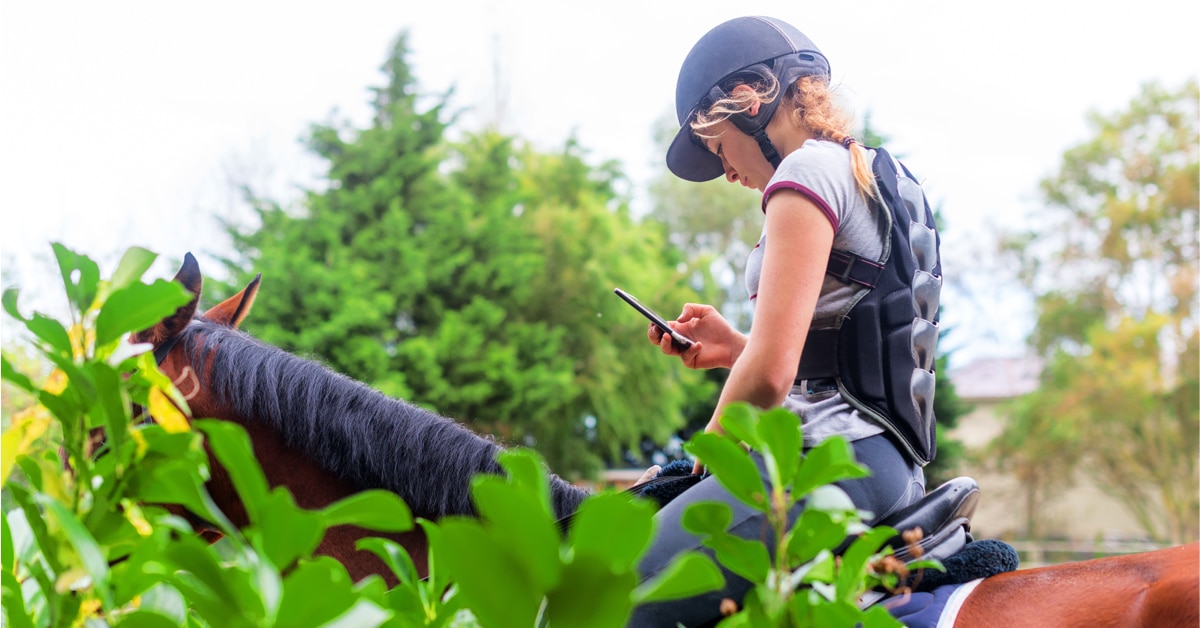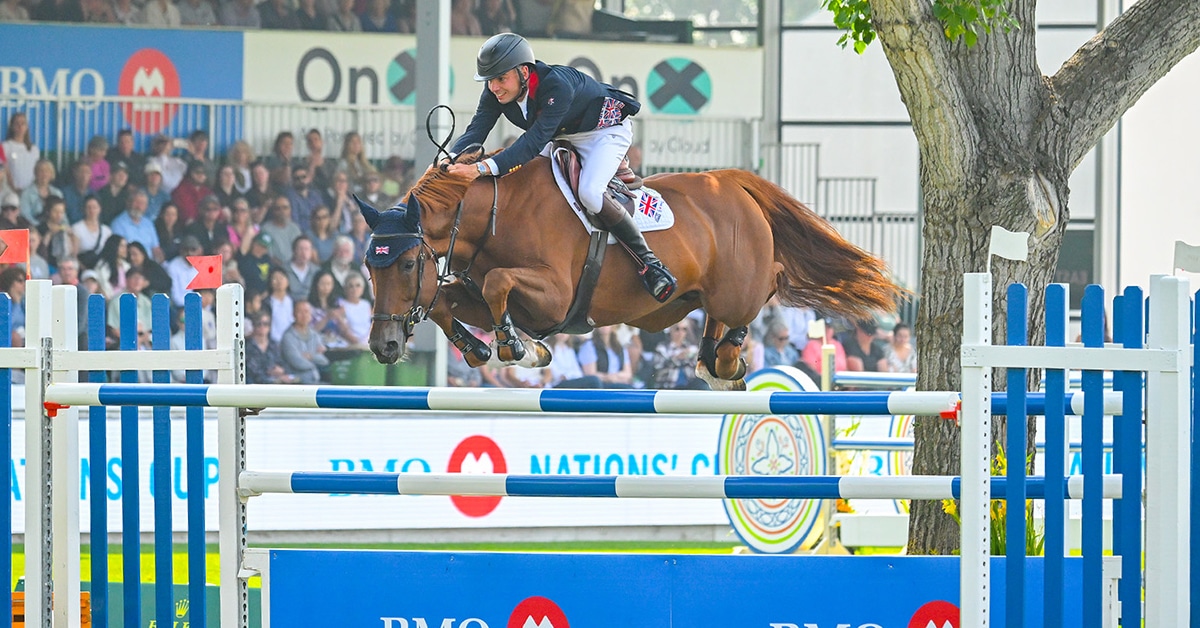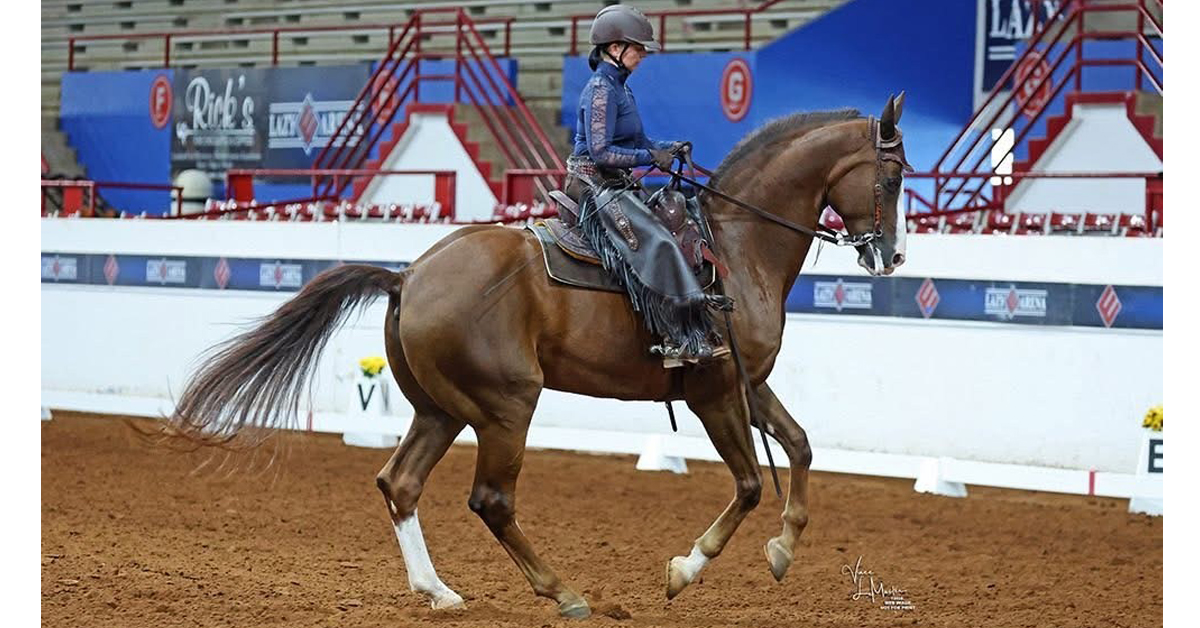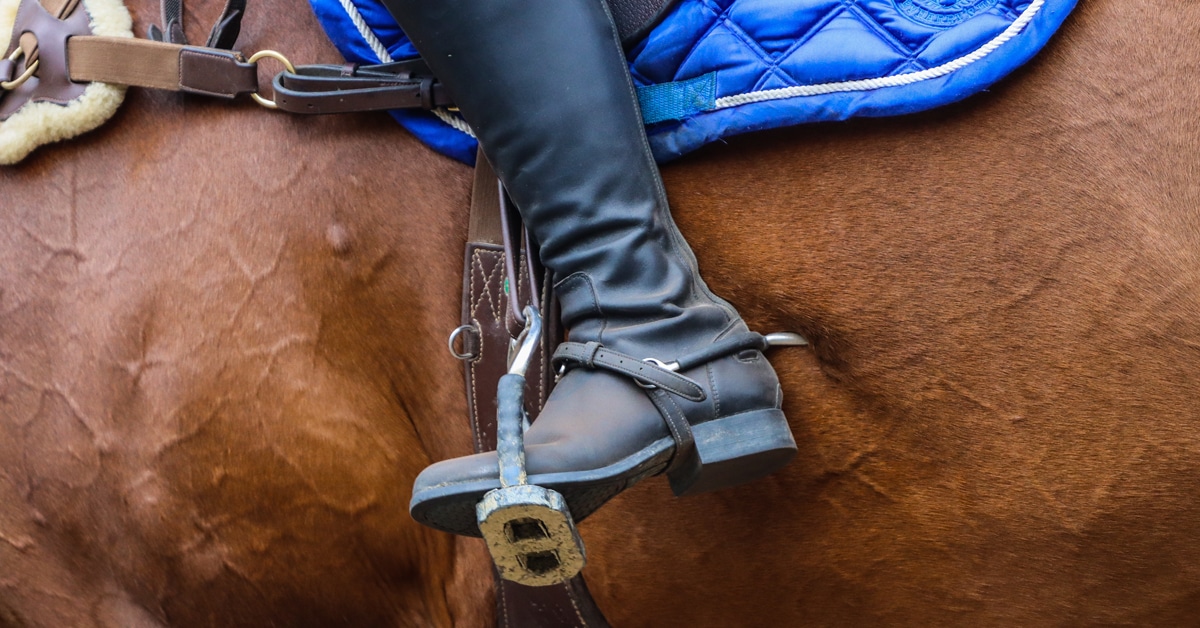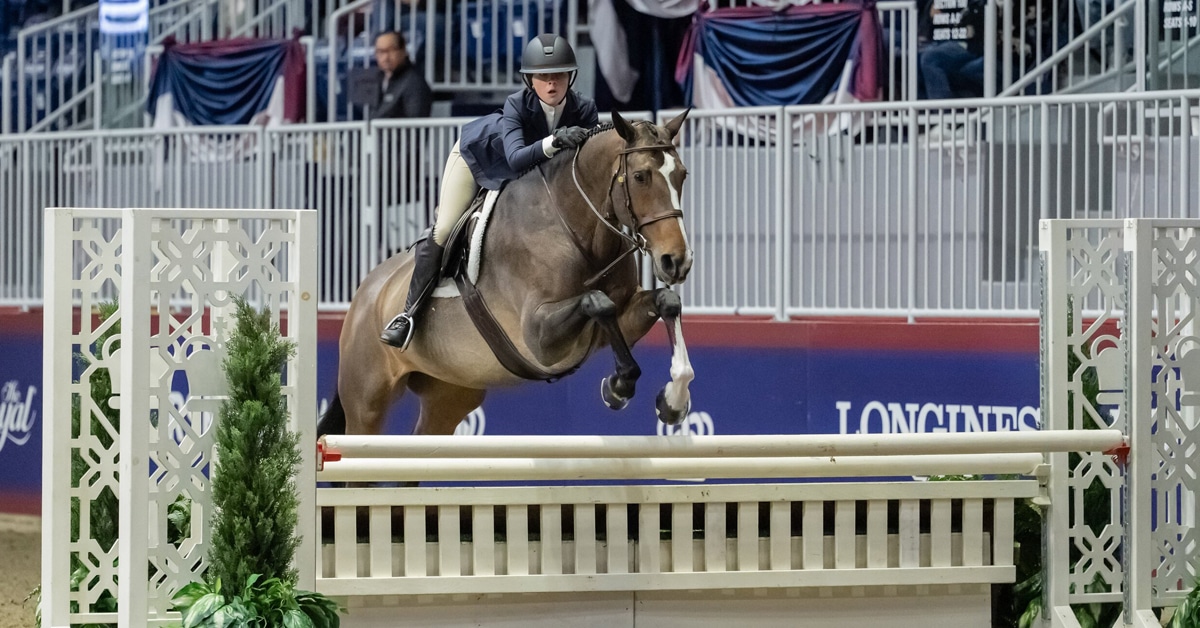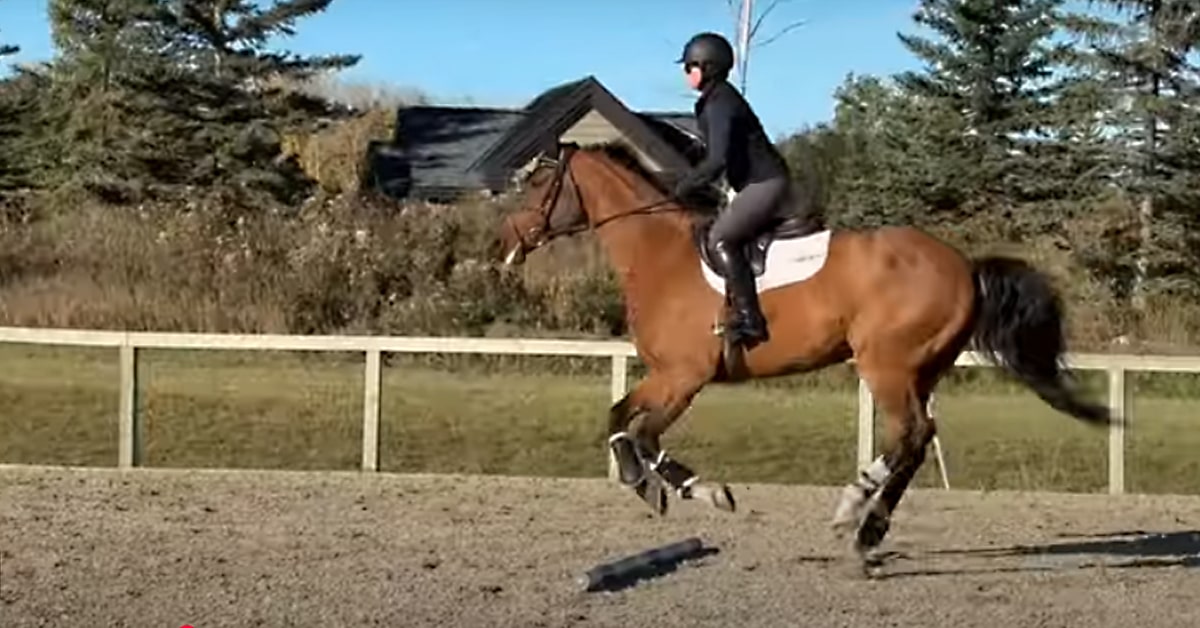Perhaps one of the most important things a rider can do to ensure she feels safe and secure in the saddle is to develop strength and consistency in her leg position. When a rider has a solid lower leg that stays correctly in place under her hip even if the horse trips, spooks, or does something else unexpected, it is probably the closest she can come to wearing a seat belt while in the saddle.

The two exercises in this chapter—Two-Point/Chest Press and One-Handed Chest Press—are based off the rider’s ability to execute a correctly balanced two-point position. If this is a new position for you, be sure to review “Two-Point Fundamentals for Equicize,” back in chapter 3 before proceeding further. But riders will also need to practice another new position to do these exercises—Chest Press. Chest Press is often novel even to jumping riders, and I will break it down in more detail below.
Not only are these two exercises guaranteed to bring a bit of heat to your leg muscles, they will also elevate your heart and respiratory rates. As you begin to practice this sequence, be sure to listen to your body and take short rest breaks as needed. It is more useful to do fewer repetitions correctly than many repetitions in poor balance or incorrect form.
Two-Point/Chest Press
Once a rider has practiced the transition from two-point to Chest Press at the halt and walk, she is ready to take it into the trot. In this exercise, the rider will coordinate her transitions between these two positions with the horse’s stride.
To get started, establish a positive forward posting trot. Choose a marker along your arena (fence posts can work well if you don’t have arena letters) and transition to two-point at that marker. Hold your two-point for a count of five, then transition to Chest Press for a count of five. Continue alternating between these two positions on a count of five for two full circuits (figs. 6.1 A & B).

6.1 A & B | Reina performs the Two-Point/Chest Press by starting off in the two-point position and holding it for a count of five (A). Reina now transitions to her Chest Press position and holds for a count of five (B).
Chest Press
The Chest Press is essentially an ultra-deep two-point position, used to help riders home in on their center of balance and to build strength. It is not a position riders would typically use while navigating a course of jumps or out on a foxhunt, and in my experience, even seasoned jumping riders find Chest Press to be a challenge, at least at first.
Because Chest Press is based on the two-point, let’s first do a quick check-in on your technique in this position. Starting in the halt or walk:
1. Slide your lower leg into Power Leg.
2. Engage your leg muscles and lift your seat from the saddle.
3. Sink your weight into your heel and ensure your ankle, knee, and hip angles close.
4. Check that your center is over your horse’s center, not over the pommel of the saddle.
After making any required adjustments to your position, transition into posting trot for a few strides, then reestablish your two-point position. When the rider adopts the two-point position in the trot, the energy involved in the movement of the horse’s limbs and his moment of suspension radiates through the rider’s body, challenging both her position and balance. If you find that your upper body tips forward or you collapse onto the horse’s neck, it is most likely that your lower leg has slipped back. Return to walk, reset the Power Leg, then try again. If you are falling back into the saddle, check that your lower leg hasn’t slid too far forward. This can happen especially when a rider’s stirrups are too long, making it difficult to close the shock-absorbing angles of the ankle, knee, and hip. Only after a rider is fairly comfortable with the two-point will she be ready to attempt a Chest Press.
When you feel confident in your two-point, try the Chest Press as follows. Start in a balanced two-point at the halt or walk. From two-point, close down the angle of your hip even farther, pressing your seat back toward the cantle, until your pelvis is almost parallel to your thighs (figs. 6.2 A & B). Your back remains flat, and your chest is pressed down toward the horse’s neck. Your arms and hands can stay out ahead of you along the horse’s crest, as though you are performing a crest release. Until you get stronger, press your hands down onto the crest, or even grab some mane, to increase your stability. Over time, work toward the goal of holding your balance in Chest Press without this modifier. A correct Chest Press almost looks as if the rider is lying upon her horse’s neck—but instead, her leg and back muscles are active and engaged, supporting her upper body.
Performing either the two-point or Chest Press at the halt or walk challenges a rider’s strength immensely, as there is no energy from the horse to help her stay out of the saddle. However, it is much easier to correct position, alignment, and balance issues at these slower speeds. If a rider is practicing her Chest Press at the trot and gets discombobulated, she should return to either posting trot or the walk to get reset and re-centered.

6.2 A | Tami performs the two-point as her starting position to learn the Chest Press. She makes sure her legs are underneath her seat and placed in the Power Leg, then rises her seat up out of the saddle without straightening her knee angle.
6.2 B | Once Tami is well balanced in the two-point, she folds deeper into her Chest Press, pressing her seat toward the cantle with a flat back. A correct Chest Press almost looks as if the rider is lying upon her horse’s neck, but instead, her leg and back muscles are active and engaged.
As a rider becomes fitter and more comfortable executing two circuits of Two-Point/Chest Press on the five count, it is time to add on. As you approach the arena marker after completing two circuits of “fives,” keep going, but transition to holding the two-point for a count of four, then Chest Press for a count of four. Repeat this sequence for one full circuit.
Over time, riders will continue to build until they can successively complete:
• Two circuits of fives (hold two-point for a five count, then Chest Press for a five count).
• One circuit of fours (hold two-point for a four count, then Chest Press for a four count).
• One circuit of threes (hold two-point for a three count, then Chest Press for a three count).
• One circuit of twos (hold two-point for a two count, then Chest Press for a two count).
Counting Circuits and Choosing Your Challenge
Although we perform most of the mounted warm-up exercises for one circuit each, I prefer to start with two full circuits of Two-Point/Chest Press. This ensures the rider is truly executing the correct leg and body technique in each position, while also beginning to increase her cardiovascular output. Riders quickly become aware which of their muscles are up to the challenge, and which are just “along for the ride.”
If at first two circuits of this exercise at the trot are not possible, make it your goal to work up to that duration for maximum benefit. And if practicing Two-Point/Chest Press at the trot is simply too much for your body right now, you will still receive tremendous benefit from performing this exercise at the walk. Use the same five count, and beginning with the two-point, alternate between these two positions for one full circuit. The slower speed and lack of impulsion in the walk will still offer plenty of challenge for riders who choose to use this modifier!
I can assure you that after completing five successive circuits of Two-Point/Chest Press on a decreasing count, your heart and respiratory rates will be up and the sweat will be pouring down!
An important note: I do not recommend doing counts of one. With “ones,” the required transition between the two positions is so quick that riders almost universally switch to using their back muscles instead of their legs. This is incorrect biomechanically and defeats the purpose of the exercise. We want the Everyday Rider’s legs to do the heavy lifting!
For many riders, working up to completing the full sequence successively—fives, fours, threes, and twos—will be plenty of effort. But if it starts to feel easy, change rein, and work up to repeating the sequence again. Alternatively, riders can add additional circuits to each count. And when even that feels too easy, try it without stirrups. Remember, it is up to you to determine your personal edge.
Throughout this process, pay close attention to your heart rate and breath. As bodies fatigue, some riders hold their breath, while others breathe faster and faster, restricting their chest muscles. It is important to maintain a steady flow of oxygen to help fuel your muscles, so if you notice your breath has become inconsistent, this is a good cue to back off the intensity by returning to the posting trot for a circuit, or even taking a walk break.
To order your copy of Equicize from Trafalgar Square Books, visit here.
The Latest
